Martinez High School Hosts Suicide Prevention Event
BY JOE PORRELLO
Mcame together Sept. 13 at Vicente Martinez High School for an event aimed at spreading awareness of suicide prevention and sharing resources.
The gathering was a part of Suicide Prevention Week, budding out of a partnership between the Prevention and Early Intervention program and the Find Your Anchor program.
Contra Costa County’s PEI program is funded through the California Mental Health Services Act, which became law in 2004 with the passage of Prop. 63.
Find Your Anchor uses the building and giving of boxes filled with uplifting contents, services and information to spread positivity and mental health resources.
“I’ve never seen anything like this before,” said Liberty High School counselor Tanya Silva.
Started in 2012 by Alexandra Borowsky in Long Beach, the initiative became an official nonprofit in 2018 and is now featured in over 40 countries; it has even partnered with the San Francisco 49ers on several occasions.
“I created Find Your Anchor because

US
Have questions, comments, or want to get involved?
Contact Richmond Pulse at:

info@richmondpulse.org
www.richmondpulse.org
I’d make something myself.”
After having made 250 boxes just five years ago, Find Your Anchor has now made over 65,000.
The box-building at Martinez High was the first event of its kind in Contra Costa County. Borowsky hopes it results in more care packages being in the area and more residents becoming aware of the resource.
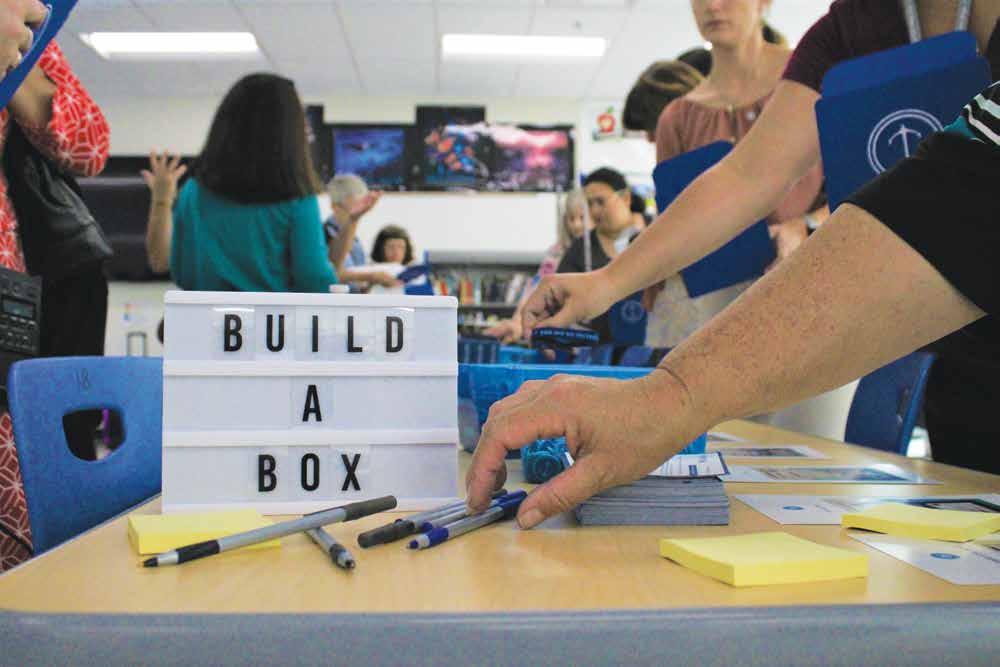
Those in attendance collectively made 300 boxes in just the first hour, containing things like handwritten notes, stickers, pins and bracelets.
“There’s something really powerful that happens when community members make the boxes,” said Borowsky.
Attendees could take the boxes and either give them to someone they know in need or leave them somewhere to brighten a stranger’s day.
Many of the programs had a speaker on hand to talk about their initiative’s approaches and strategies.
Contra Costa Crisis Center has a 24hour suicide hotline available by dialing 211 or 988 that has been operating for 60 years.
“If you want advice and tips on either
ABOUT US

The

Hunt. “If you don’t know what to say or do, they’re there to help.”
A3 Crisis Response is open 8 a.m. to midnight every day with licensed clinicians available to call for help.
Seneca Mobile Response Team has a team of counselors and clinicians that respond in person when called during crisis situations regarding someone in the age range of 0-22.
The Wellness in Schools Program helps support schools with mental health awareness and stigma reduction services by educating parents, students and staff.
“I would love to see this type of event happen during school,” said WISP representative Edmund Arnold.
Martinez High School student Lilithia De La Cruz believes students would participate in and benefit from box-building events if they were held during school hours, like during lunch.
“I feel enlightened; this whole thing has actually made me a lot more happy,” she said.
Silva noted that at Liberty High, many students struggle with mental health and could use similar sorts of gatherings.
“Any place that we can find resources
Mental Health program supervisor, noted one of the biggest problems with getting events like these underway and executed is making people aware of their existence.
“I’d imagine if you ask any number of members of the community in Contra Costa County if they knew that this was happening today, they’d probably say ‘no.’ There needs to be kind of a call to action,” she said. “It’s really hard sometimes to get through all the weeds, but I think the opportunity is there.”
The last MHSA community forum on suicide prevention was two years ago and held virtually due to the pandemic.
“It’s nice to see something like this here and to see such a good turnout,” said Arnold. “It warms my heart.”
About 50 people were in attendance, walking away with professional advice on how to prevent suicide.
Contra Costa Crisis Center Director of Programs Lesley Garcia said untrained people can also make a difference by assisting their friends and loved ones who are having troubles with mental health.
See Prevention, pg. 6
CONTACT
Contra
Pulse is a community media
local and
Fund. Community News, Youth Voices www.richmondpulse.org Fall 2023 In Pictures: Pittsburg Seafood and Music Festival Returns See Pg. 8 Richmond Homicide Numbers Continue to Trend Downward See Pg. 3
Costa
project focusing on
health news coverage in West and East Contra Costa County. The project is supported by STRONG Collaborative
Staff
Publisher
Malcolm Marshall
Editor
Danielle Parenteau-Decker
Contributors
Jonathan Hale
Sasha Abigana
Natasha Kaye
Joe Porrello
Samantha Kennedy
Emily Tenorio Molina
Denis Perez-Bravo
Advisors
Vernon Whitmore
Sandy Close
Michael J. Fitzgerald
The
DeSaulnier Hosts Town Hall at Contra Costa Animal Services
BY NATASHA KAYE
Rep. Mark DeSaulnier, D-Walnut Creek, held a town hall meeting for his 10th District constituents at Contra Costa Animal Services on Aug. 28 to provide updates from Washington and address concerns about his efforts to protect animals in the county and nationwide.
DeSaulnier kicked off the town hall with a PowerPoint, introducing the audience to his own rescue husky, North, and also advocating for the adoption of shelter animals, a sentiment that was applauded by the crowd.
He said the current municipal shelter in Martinez was opened by the Board of Supervisors in 2005 under legislation from the late Tom Hayden, a former California senator who also pushed heavily to make California a “no-kill” state, meaning no animals that enter municipal shelters would ever face euthanasia.
“So we’ve got a lot of history, but a lot of problems with that vision is that we haven’t been able to fund it, in my view, to the degree that we want it to be successful,” DeSaulnier said.
Recently, CCAS has faced criticism from animal advocates who say the shelter is not doing enough to adopt out animals in their care.
One animal rights group, People for Animal Advocacy and Welfare, was in attendance, all wearing white shirts in solidarity to show their disappointment in the state of animal welfare in Contra Costa County.
The shelter has been at maximum capacity since the start of the year and has had to euthanize over 500 animals since January, according to its records. Irresponsible breeders and neglectful owners directly contribute to pet overpopulation, exacerbating the issue for CCAS.
“Animal shelters and rescues in the Bay Area and around the state are overcrowded due to an influx of animals coming
into our shelters and rescues, and the flow of animals being adopted from all of our groups — fosters and transfers — is far outpaced by the number of animals we see each day,” Beth Ward, director of CCAS, said. “This is a community-wide problem that requires a community-wide solution.”
DeSaulnier made a point to say that not all counties are funded equally and that much of the funding for municipalities comes from property taxes. He noted that after Prop. 13 was passed in 1973, more urban counties like Alameda and San Francisco voted to raise the property tax aggressively, while Contra Costa, with its more rural settings, only raised it slightly, resulting in less local revenue in the general funds.
He said the departments that received the biggest budget cuts because of this tax structure are juvenile probation and animal services.
“When you compare how we do animal services here, from my memory being on the board, you look at Alameda or Santa Clara or San Francisco, they have a lot more of this funding that allows them to draw out more money and do more creative things,” DeSaulnier said.
During the question-and-answer portion, one constituent asked why CCAS does not advertise its adoptable dogs at public events like municipal shelters in Alameda County do, to which Ward said CCAS depends on volunteers to commit to those events.
One constituent brought up that DeSaulnier is not a co-sponsor for Senate Bill 271, a.k.a. the Farm System Reform Act of 2023, which aims to place a moratorium on concentrated animal feeding operations, or industrial-sized animal feeding facilities where animals are raised and fed in confined spaces to reduce costs and increase meat, dairy and egg output. In response, DeSaulnier said he was surprised he wasn’t aware of it but now plans to sign on.
Although the town hall was held at CCAS and was advertised both as a “Washington update” and updates on DeSaulnier’s efforts to protect animals, many of DeSaulnier’s talking points focused only on his work at the federal level. He boasted that since being elected in 2015, he has secured funding for 25 community projects, totaling roughly $30.8 million, and also highlighted Democratic achievements in Congress.
After several questions were chosen to be answered on non-animal-related themes, the crowd began to complain.
DeSaulnier attempted to calm the audience by saying the event was a congressional town hall and constituents had the right to ask whatever they wished.
In another question that did concern animals, one constituent asked when penalties for backyard breeders would be increased.
“I don’t think there’s anyone in this room that doesn’t think enforcing laws for backyard breeding is not important. Backyard breeding is probably one of the No. 1 reasons we have for animals entering our shelter. The problem we have is enforcement,” Ward said. “It’s not just about laws; it’s about the capability to do the enforcement.”
She noted a significant staffing shortage in the animal enforcement branch, which limits the shelter’s capability to enforce the existing laws.
“In things like this, I think the best role we can play is looking at best practices around the world and giving the state and locals the information and resources and being able to compare performance,” DeSaulnier said in closing. “When we invest in these things, we want to make sure we accomplish the goals we set out, and in this instance, it’s to make sure the animals don’t lose their lives unnecessarily.” •
Filmmaker’s Career Began on the Richmond ‘Greenway’
BY JONATHAN HALE
Jed Lee’s career as a filmmaker began when they were an undergraduate at UC Berkeley, documenting the Richmond Greenway for a class called Engineering, The Environment, and Society.
The project is supported by The California Endowment and the STRONG Collaborative Fund.

Inquiries
Have questions, comments, or want to get involved?

Contact Richmond Pulse at info@richmondpulse.org www.richmondpulse.org

The Richmond Greenway is a 2.5-mile stretch of verdant parkland that was once home to an abandoned railway. Bike and pedestrian passageways run alongside gardens of native plant life as the Greenway passes west to east through Central Richmond.
That class project led to Lee’s debut film, “Greenway.” Lee was inspired by the collective action that led to the Richmond Greenway’s creation and felt driven to tell the story of the park and community stakeholders involved.
“There’s a story here that’s so enriching that I wanted to keep working on it,” Lee said, describing their impetus for undertaking the project.
Lee partners with local organizations and communities to uplift untold stories hidden in plain sight. During the making of “Greenway,” the filmmaker was inspired by Richmond residents’ civic pride and hospitality as they shared their memories.
“All the folks I talked to in making that first film were just so open and willing to share their stories,” Lee said. “I was
let into people’s homes, I was shown photos, and people talked about what the Greenway meant to them.”
The film, a story of 17 different nonprofits collaborating with city leaders to make the project a reality captures the spirit of reclamation and resilience of the Richmond Greenway. Once a neglected and rusty industrial site, it is now a vibrant community space.
The feature film, with a runtime just shy of 1½ hours, documents the creation of the Richmond Greenway and the success of a city on the rise. “Greenway” is a celebration of citizens coming together to make meaningful changes in the community in which they live.
“Greenway” has garnered critical acclaim, last year winning Best Documentary Film at the Our Heritage, Our Planet Film Festival and Best Film for Environmental Activism at the International Social Change Film Festival.
Since then, Lee has hosted film screenings for supporters and Richmond residents, including one July 28 at the Richmond Memorial Auditorium & Convention Center, with current Richmond Mayor Eduardo Martinez and former Mayor Tom Butt among those in attendance.
Now, Lee is working on a film centered on Rich City Rides, a Richmondbased nonprofit that promotes cycling as a healthy sustainable form
of transportation. With its focus on bicycling in Richmond, Rich City Rides is featured in “Greenway.” But again, Lee wants to take things further.
“Rich City Rides is really doing grassroots organizing and providing services to bolster community culture in Richmond and community pride in Richmond,” said Lee.
The forthcoming film incorporates a series of interviews with Rich City Rides participants and collaborators, interweaving stories of bicycle culture and the city of Richmond.
A recurring theme in Lee’s work is environmental positivity. Through film, Lee tries to spotlight the positive effects that grassroots organizing can have on promoting environmentalism at a local level. They hope this can show others that they too can carry out similar projects in their cities.
“What these organizations, what Rich City Rides (is) doing, is a model for building healthier societies,” Lee said.
Lee’s films are meant to document the legacy of activism and collaboration in Richmond, giving credit to the organizations that have worked for year, or even decades, to make the city a better place.
“It’s not about me,” Lee said. “It never has been.”
Updates and more information on “Greenway” can be found on Facebook. •
2 Community News, Youth Voices www.richmondpulse.org Fall 2023
Contra Costa Pulse is published by Richmond Pulse, a community media project founded by New America Media, focusing on local and health news coverage in West and East Contra Costa County.
Support Richmond Pulse! Scan the QR code above to go to our donation page.
BY JOE PORRELLO
With six murders in the first seven months of this year, the city of Richmond is on track for one of its low est homicide rates in more than 20 years.
Richmond Homicide Numbers Continue to Trend Downward Antioch Council Reverses Decision, Won’t Control Hiring, Firing Police Chiefs
From 1999-2018, the lowest rate of homicides in Richmond per 100,000 residents in recent years was about nine in 2017 — the only year since 1998 when it was below double digits, according to macrotrends.net, a research platform that uses FBI database information to report its statistics.
While the rate has fluctuated over the years, it has been coming down, for the most part.
“Culture doesn’t just change overnight,” said Richmond Mayor Eduardo Martinez. “It just takes time because it’s a changing of attitudes — a changing of values.”
To accelerate that change, multiple community groups have been trying to curb gun violence in Richmond since the mid-to-late 2000s, when murders were at their peak.
Dewanda Joseph grew up in Richmond and has been an activist for most of her life. She started her organization Ya-Neema Healing Circle and Support Services in response to the 2010 shooting death of her nephew Ivan Thompson in El Sobrante. Ya-Neema offers support to families struggling through the trauma of gun violence.
“I’m thankful for the activists who have stayed engaged in community after we’ve had so much trauma in our city,” said Joseph. “As we engage in our community with the youth, we give them other options to look at and help to divert them from activity that may be unsafe for them.”
Developed in 2007, the city’s Office of Neighborhood Safety also tries to limit gun violence by working both with those committing it and with victims.
“A lot of the people we work with are thinking twice about pulling the trigger to settle a dispute,” said ONS worker Joe McCoy. “The issue is that they didn’t have the services or service providers to be able to help them go from one step in life to the next step.”
Martinez says the work ONS does is crucial to the Richmond community. “I think they’re great mentors.”
According to CNN, Richmond experienced its peak in homicides in 2007 with nearly 50. That made it No. 2 in the U.S. at the time. About 50 more murders happened in 2009, prompting the city to consider bringing in the National Guard.
“I was there on the daily — like on the block when everybody was having wars — and I was meeting with individuals in the middle of the night, with shooters to try and get them to stop,” said Bay Area Peacekeepers founder Gonzalo Rucobo. He began working in violence prevention during the 1990s following his own involvement with gangs, launching Peacekeepers in 2005.
“There’s a lot of beautiful stuff that comes out of Richmond, but there’s also some negative mindsets and ways of dealing with things in a non-constructive way,” said Rucobo. “We help them develop a decision-making process.”
Rucobo said the city’s youth programs are great but not enough. He said a number of factors have contributed to the decline in homicides. For example, the pandemic kept people inside, which meant potential shooters weren’t on the streets as much.
The cost of housing pushing some people out also played a part, according
to Rucobo.
Richmond’s Black population shrunk from 26.6% in 2010 to now under 19%, according to U.S. census data. The number of white residents grew 5% at the same time.
Rucobo said Richmond residents being forced out has affected the culture. “They pretty much moved the North Richmond community out to Vallejo and Antioch and Rodeo when they knocked down the projects,” he said. “There’s a lot of history there that kind of just got wiped away.”
Rucobo also said gun violence largely depends on “who’s in jail, who’s out and who’s coming home.” Some individuals stir up controversy and lead semiorganized crime groups. “If there’s not a beast in the streets training other people to be beasts, then it slows it down.”
He also said it’s important to stay in contact with families who lose loved ones to violence, as retaliation plays a large role in the number of Richmond murders. “Their son gets old enough, and someone points out, ‘Hey, that’s the one that shot your dad,’ ” said Rucobo.
“Usually, there’s a shooting and then another shooting right behind it that sets off a chain of events,” Dewanda Joseph agreed.
In August 2022, four homicides occurred in one week, while 11 murders took place within seven days in May one year prior.
Joseph believes those committing homicides have matured with age and the younger generations are making better decisions with proper community guidance. She also pointed to the work of the Richmond Police force, saying officers have become more personable and that Police Chief Bisa French “shows up pretty much everywhere.”
“We’ve had the opportunity to have conversations with detectives and investigators, and they’re open with communication,” she said. “Not everything always gets resolved, but we get to see what our justice looks like.”
But Rucobo said Richmond Police often take very long to respond, a situation French said her department is trying to rectify even with a short-handed staff.
She pointed out that an officer only has to give two weeks’ notice to quit, but a new police officer may need up to 18 months before officially starting because of training and other logistical hurdles.
Joseph and Rucobo echoed each other’s sentiment that communal events such as monthly lowrider cruises have a positive effect by bringing people together and, thus, reducing violence.
“Both of our opposite gangs are out there, Norteños and Sureños cruising and not fighting each other,” he said.
Death and imprisonment may have also lowered the number of killings. “We lost a lot of people that were active during that time, and a lot of folks were incarcerated,” said Rucobo.
“The street life is street life. It’s not going nowhere; it just evolves and tries to get smarter on how they do things,” said Rucobo. “We don’t know what the new thing is going to be…we have to adjust to what comes into play.”
In June, a search warrant led Richmond Police to find 23 pistols, 20 rifles, eight revolvers, two shotguns, a live hand grenade and large amounts of ammunition in one man’s home — illustrating guns are still widespread in the city.
Rucobo said other crimes are rising while homicide numbers fall, namely domestic violence, drug dealing and prostitution, which he said are all often slippery slopes leading to murder.
There have already been 63 sexual assaults in Richmond through July, putting it on pace for 108, which is in line with the totals from 2021 and ’22. The city is also again on pace see its number of aggravated assaults land between 800 and 900, just like the last two years.
Rucobo said now is not the time to act as if the violence in Richmond is over, but instead be just as vigilant, because people will listen more intently when they are not surrounded by murder.
“In the heat of the moment, it’s harder to penetrate and get them to listen to reason,” he said.
Joseph had a similar take.
“The brain can begin to function without the constant reminders of guns and gun violence, and funerals, and death, and rest-in-peace signs everywhere, and flowers on corners,” she said.
Both Joseph and Rucobo noted the power of adversity in changing things for the better.
“I’ve heard someone say turn your pain into power,” she said. “They are staying vigilant in seeking assistance, giving assistance and supporting one another.”
Joseph said the cohesiveness of Richmond’s people gives her hope. “The support I’ve seen from families and persons when called upon has been great,” she said. “We lack a lot of resources, but we’re also a creative community. We come together and find ways to support each other.” •
BY SAMANTHA KENNEDY
After voting at its last meeting to take control of the hiring and firing of the police chief, the Antioch City Council decided against transferring the power to the council.
At its Sept. 12. meeting, Mayor Pro Tem Tamisha Torres-Walker pulled the proposed ordinance from the consent calendar to further discuss adding an amendment that would eventually pass the power back to the city manager, as she had suggested at the Aug. 22 council meeting. The amendment — and with it, the ordinance — failed 2-3, with Mayor Lamar Thorpe and council members Michael Barbanica and Lori Ogorchock voting against it.
Any further action on the current ordinance cannot be taken.
Torres-Walker, who previously voted in favor of the ordinance, posted a video on her Facebook page explaining her intention to not support the ordinance should her amendment not pass.
“I think that the compromise that I suggested at the last council meeting was a reasonable one,” Torres-Walker said in the Sept. 11 video. “I believe in balance, leadership. Sometimes you just have to move things because it’s necessary to move things on behalf of the community because things have been stagnant for so long.”
The ordinance would have granted the council power to hire and fire a police chief; however, Torres-Walker’s amendment would have given that power back once a permanent city manager was hired or at the end of 12 months, whichever was sooner.
Council member Monica Wilson said she decided to vote in support of Torres-Walker’s amendment after having several weeks to think about imposing a time limit.
Thorpe said he could not support the amendment because his values tell him the addition of the amendment would not make the ordinance proper policy.
“The purpose of this is accountability,” Thorpe said. With the addition of this amendment, he said, there “will never be oversight” of the police chief.
“I do believe that radical action needs to be taken to address the challenges we are all facing when it comes to quality non-biased policing services in the city of Antioch,” Torres-Walker wrote alongside her video.
In response to residents suggesting she was being influenced by outside forces, she said she was only influenced “by my values and a conscience.”
“A lot of times, when people who haven’t had power get a little, they misuse it,” she said. “That can happen in politics. That can happen among city council.”
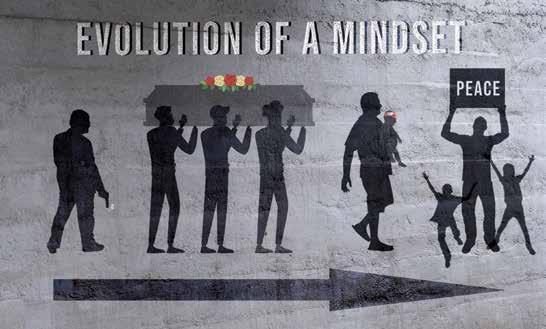
Torres-Walker also said the responsibility of police chief oversight to a city council whose workload is piled on top of working full-time factored into her proposing the amendment.
Antioch’s acting City Manager Kwame Reed was appointed at the end of June.
3 Community News, Youth Voices www.richmondpulse.org Fall 2023
See Antioch, pg. 6
DENIS PEREZ-BRAVO
Drive-Thru Baby Shower Gives Expecting Black Parents Services and Support
STORY AND PHOTOS • DENIS PEREZ-BRAVO
In a display of community solidarity, hundreds of expecting mothers and fathers received a plethora of resources Aug. 26 during the 11th annual Contra Costa African American Community Baby Shower at Bethlehem Missionary Baptist Church in Richmond.
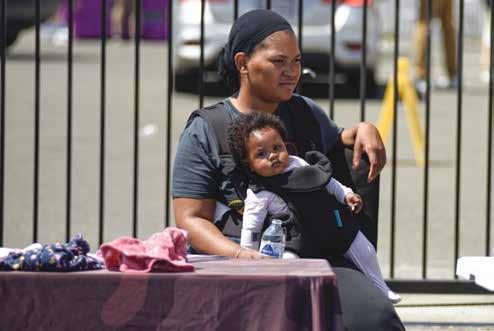
A convoy of residents drove or walked up to receive assistance from a variety of organizations all brought together by A More Excellent Way, an organization that partners with churches in Contra Costa and Solano counties to provide health services for pregnant people.
The vibrant tableau of booths lining the sidewalk and parking lot offered a range of services that parents could readily access.
Parents were able to get a lactation consultation, curated bags brimming with essential supplies, informative resource materials, books, diapers and various other essentials.
“Sometimes your family is not there. And so the community can become your family,” said Richmond resident Braghette Price, 40.
As a walk-up participant, she said she found herself immersed in an atmosphere of care and assistance that has been transformative for her family. Price said the church and the various community organizations it
partners with have given her confidence and peace of mind knowing that there’s someone advocating for her and her family.
She attended the event to get supplies for her 1-month old Messiyah Jacskon, whom she had wrapped in front of her in a Ghanaian traditional style learned from Cynthia Obleton of Fawohodze Inc., an organization in attendance.
That was Price’s first time being exposed to Tur Wo Ba, the Ghanaian baby-wearing style. She said she would wear her child like that more often as it was very convenient as she walked from booth to booth.
“I started my organization to help the community improve,” Obelton said. Their dedication is evident through not only the provision of valuable resources but also through educational cultural expeditions to Ghana, enriching after-school programs, adult literacy initiatives, and the nurturing Tur Wo Ba classes, all of which were on display at the event.
In total, 180 families were registered as drive-up participants.
“When a mom is pregnant, you need that partner. You need the community to support them,” said 62-year-old Dr. Monique Sims, a Vallejo resident and founder of A More Excellent Way and the community baby shower. “This event was birthed out of my dissertation research
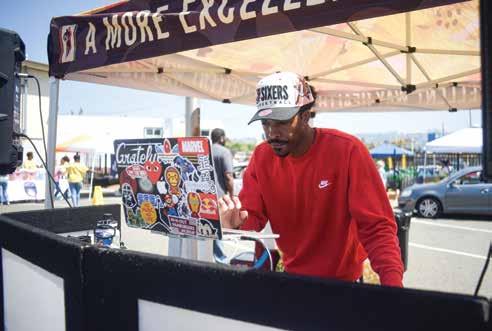
around improving the perinatal outcomes of African American women.”
In 2003, Sims learned a daunting statistic that set her on a course to help her fellow Black women.
“I found out about the health disparities that exist,” she said. “Women that identify as Black die at four times the rate as other mothers.”
So she created an event in East County that brought service providers together for the benefit of the Black women in that community. This year, the Solano County African American Community Baby Shower celebrated its 19th year.

But she soon saw a need to expand the community baby shower initiative to Contra Costa County.
“My experience (in Contra Costa) was that it ramped up faster than it did in Solano County, just because of all the interagency collaboration,” she said.
When she began in Contra Costa, she was welcomed by organizations like Black Infant Health, the Women, Infants and Children supplemental nutrition program and the Early Head Start program.
“All of those kind of came around, like, we don’t want the statistics to persist. We want Black women, Black babies to thrive at the same rate as other mothers,” Sims said. •
4 Community News, Youth Voices www.richmondpulse.org Fall 2023
Mia Robinson sits with her baby, 9-month old Aubrielle, at the community baby shower.
DJ Tonio kept the music going at the community baby shower.
Mia, from top left, 9-month-old Aubrielle and Brianna Robinson at the 11th annual Contra Costa African American Community Baby Shower on Aug. 26 in Richmond.
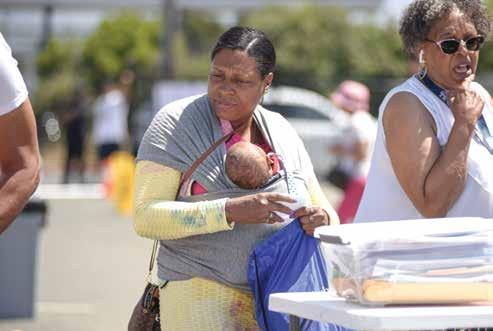
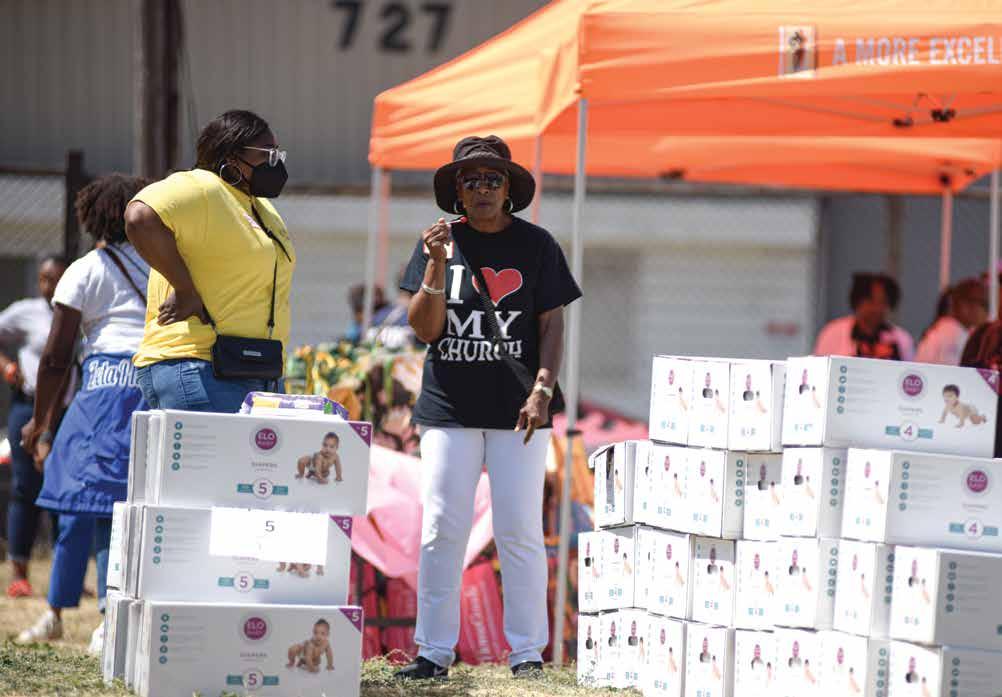
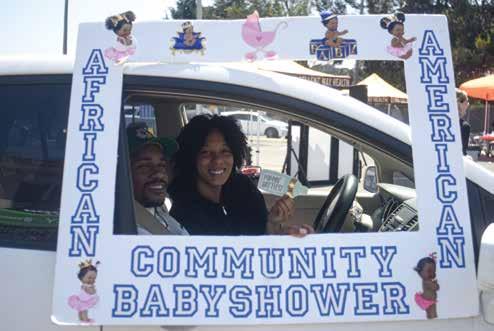
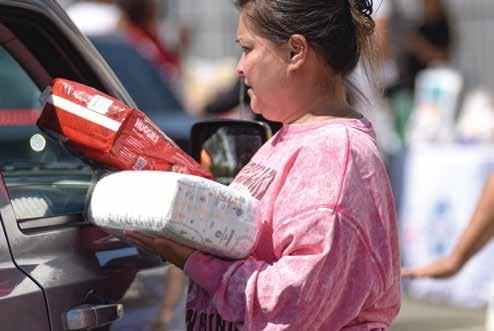

5 Community News, Youth Voices www.richmondpulse.org Fall 2023
Braghette Price said carrying her baby, 1-month old Messiyah Jacskon, in the Ghanaian style called Tur Wo Ba, which she learned at the shower, made getting around more convenient.
Lynn Sims, 72-year-old Richmond resident in black shirt, stands by the supply of diapers given out at the community baby shower.
A couple attends and celebrates the drive-thru baby shower.
Pittsburg resident Kelly Andrade, 47, hands out diapers during the baby shower event.
Expecting parents could get supplies and other resources without leaving their cars at the drive-thru community baby shower.
The Jefas Encompasses Latina Beauty and Business
BY EMILY TENORIO MOLINA

Richmond entrepreneur Aurora Diaz has built successful a beauty industry business — called The Jefas — targeting the special needs of Latina consumers.
The online-only business sells beauty boxes with samples of skin and beauty products from Latina-owned businesses like Vive Cosmetics, Untamed Naturals and VAVICA and from community-conscious cosmetics brand EVIO, which Diaz markets to the diverse needs of Latina women.
About $2 billion was spent on makeup in 2019 by Latina consumers, according to the global market research firm Mintel. “Latinas are a driving force in cosmetic demand,” Diaz said.
Yet major retail brands and stores lack marketing that depicts the different skin tones of Latina buyers.
So Diaz exhibits skin tone diversity on The Jefas website, showing examples of a darker makeup product.
The word “jefa” in Spanish means “a female boss.”
“At its core, it’s a platform for Latina founders and their stories,” Diaz said of The Jefas.
Having a website where people can shop is important to Diaz. She has intentionally sought partnerships with Latina-oriented cosmetic brands to promote Latina entrepreneurs and inclusive cosmetics.
California is home to more than 21,000 Latinaowned businesses, according to the 2022 State of Latino Entrepreneurship report from the Stanford Business Latino Entrepreneurship Initiative.
Business owners who are people of color or women can face unique challenges, as covered in a recent Ethnic Media Services news briefing. But one Richmond outfit is trying to do what it can to support local minority entrepreneurs.
CoBiz Richmond, Inc, a community work hub located on culturally rich Macdonald Avenue in downtown, supports the growth and financial capital of Black and Brown start-ups.

Services like business counseling, networking mixers
Prevention...
Continued from page 1
“You don’t need to be a professional to help somebody,” she said. “Just like you don’t need to be a doctor to give CPR to somebody to save a life, you don’t need to be a clinician to save life.”
WISP hosted a Suicide Prevention Training in Pleasant Hill on Sept. 20 to give those without formal education on the subject guidance to better help people in need, especially students.
Before handing off the microphone following their speech, WISP Liaison Ali Cannon told the crowd, “To all our youth in the room, we’re here for you; we all have your backs.”
More on how to prevent suicide can be found at www.suicideispreventable.org. •
Antioch...
Continued from page 3
He will retain the power of the hiring and firing of the police chief while the city is in the process of hiring someone to fill the position. •
and start-up funding mentorship are offered at CoBiz, which have helped Diaz thrive.
“They don’t need to go to Silicon Valley. It’s right in the neighborhood,” said CoBiz CEO Wesley Alexander.
Diaz developed her entrepreneurial skills in Silicon Valley, working in marketing for cosmetic brands like Sephora and the Balm Cosmetics.

Diaz saw how little Latina consumers are represented by corporate giants like Ulta, Sephora and Target. And she said there is even less representation of Latinafunded cosmetics in stores or online.
“Lots of Latina beauty (brands) don’t have a space in retailers,” she said. “I realize that we are spending lots of money with cosmetics, yet we are not becoming founders and starting in beauty brands.”
Latino business owners are the fastest-growing commercial group in the United States with 34% growth in the last decade, according to CalMatters.
But many local start-ups encounter problems obtaining venture capital.
Less than 2% of Latino businesses receive venture capital funding, which leaves entrepreneurs having to
seek financial assistance from sources like family or friends or try to go it alone.
It took Diaz about five years to develop The Jefas as she continued her full-time marketing job to fund her business.
That five-year experience created a foundation for her success, as she built a network with Latino business organizations like FounderFamilia and Inicio Ventures. She was able to established herself as a beauty leader.
Now that The Jefas is preparing for a new order of its beauty box, there are more celebrations to come.
Recently, Diaz was selected to work with other BIPOC entrepreneurs as part of digitalundivided’s BREAKTHROUGH Oakland program, sponsored by JPMorgan Chase & Co.’s Advancing Black Pathways. (BIPOC is an acronym for Black, Indigenous and people of color.) She will connect with other women of color founders as they learn marketing and networking strategies to increase their local consumer bases.
“My superpower is, ‘I am a connector,’ ” Diaz said. “It’s not about you ever; it’s about thriving with people along the way.” •
6 Community News, Youth Voices www.richmondpulse.org Fall 2023
Richmond’s Aurora Diaz is the founder of The Jefas, an online beauty retailer geared towards Latinas. (Photo courtesy of Aurora Diaz)
Big Tobacco’s “smoke-free” future is a dangerous reality for us all.



The world’s deadliest industry is trying to rebrand itself as your friend. Big Tobacco wants to be put in charge of, get credit for, and profit off solving the number one cause of preventable death and disease – the smoking epidemic they created. Their dangerous and hypocritical rebrand promises a “better tomorrow” and “smoke-free future” with dangerous, addictive vape products while they continue selling six trillion cigarettes each year, including launching new cigarettes in California just last year.
When Californians voted to end the sale of flavored tobacco products, including menthol cigarettes, Big Tobacco quickly rolled out new cigarette brands to keep their deadly products on the shelves and pull in profits. These new cigarettes are marketed specifically to Californians through online promotions, catchy marketing, and deep discounts. This, from the same industry that says cigarettes are a thing of the past and new, “safer” tobacco products are the future.
Big Tobacco claims they are driven by product innovation to help people quit smoking but they’ve conveniently ignored the growing body of research that shows vaping increases the risk of serious long-term diseases like lung cancer and stroke and amplifies mental health conditions like anxiety and depression. Research shows that many people who use vapes to quit smoking cigarettes end up using both products, making Big Tobacco a killing.
The tobacco industry has spent decades funding studies to give their claims the illusion of credibility, paying big bucks to influence public perception, securing ‘special editions’ of scientific journals, and releasing self-funded research that says their vape products are safer.
Vape use is an urgent public health concern in California, especially among young adults. Currently, 11.2% of young adults use vapes, the highest among any age group. These young adults were among middle and high school students during the height of the tobacco industry-created youth vaping epidemic. Big Tobacco actively preys on youth to be “replacement” customers because their products kill their existing ones. And research shows kids who vape are three times more likely to be daily cigarette smokers in the future.
The real best way to undo the damage of Big Tobacco is by helping people who are addicted quit and prevent kids from starting. As Big Tobacco kills 110 Californians each day, and 30 more suffer from tobacco-related diseases, it’s critical that people who are addicted have access to free, proven quitting methods, including medical support. Using counseling and medication together gives you the best chance of quitting for good.
7 2023-Fantasyland-Print-Advertorial-JaysonBaby-9_75x13_5-ENG-R4.indd 9-14-2023 9:48 AM Duncan Channon 114 Sansome • 14th Floor • San Francisco, CA 94104 Job info Approvals Fonts & Images Saved at None Insertion Date 2 Phat Trieu / Phat Trieu from Phat Trieu by
“Big Tobacco claims they are driven by product innovation to help people quit smoking but they’ve conveniently ignored the growing body of research that shows vaping increases the risk of serious long-term diseases like lung cancer and stroke and amplifies mental health conditions like anxiety and depression.”
PAID ADVERTISEMENT T:9.75" T:13.5" C25234_5b_2023-Fantasyland-Print-Advertorial-JaysonBaby-9_75x13_5-ENG-R4.indd 09.20.2023 RQD EPSON C25234c03C_Fantasyland_Jayson_Baby_10x12_EXT_240News.tif
© 2023 California Department of Public Health
Pittsburg Seafood and Music Festival Returns

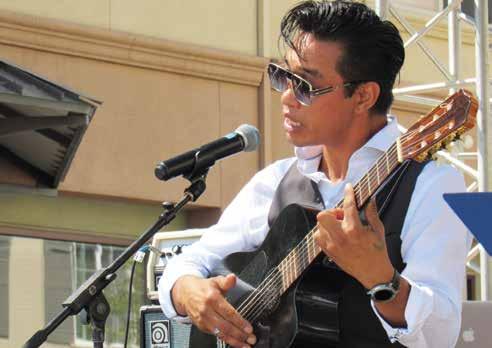 BY EDUARDO TORRES
BY EDUARDO TORRES
An East Contra Costa County staple made its longawaited return. The Pittsburg Seafood & Music Festival was back the weekend of Sept. 9 for the first time since before the COVID-19 pandemic began. Despite the festival being absent since 2019, thousands of eager people from all over the region showed up to eat seafood, listen to music and celebrate Pittsburg.
The late summer two-day festival is a tradition for East County residents and features all the seafood you can imagine, rides for kids, and live music performances on three stages. Held this year in Old Town Pittsburg, musical headliners included country music artist Clayton Q and legendary percussionist Pete Escovedo, who was honored by the city of Pittsburg.
“I was born on Black Diamond Street. You see that old house over there, that’s where I was born,” Escovedo,

88, told the crowd as he accepted a proclamation from Mayor Shanelle Scales-Preston.
“I want to especially thank all of the people of Pittsburg for supporting and just supporting my family, and just being here today. This is really something special for me.”
Joining Escovedo on stage was his family of musicians, including daughter Sheila E.

Joann Reed and her husband, Kevin, from Pittsburg were delighted to be at the festival again.
“I think it’s seeing the people, the camaraderie, the food, the entertainment, just everything. I’m glad to see it back,” she said. “After COVID, we kind of missed it for a few years. This year, I’m look forward to seeing Pete Escovedo because he was actually born in Pittsburg.”
Andrew Gonzales from Hayward said the Pittsburg community is one of the reasons that he keeps coming back. “The community, the food. They have Sheila E.
here and Pete Escovedo. It’s a good turnout. We have a lot of our family members here. I think we’re about 1214 deep.”
Gonzales also said he enjoys eating the food that the festival offers. “One is the barbeque oysters. The second is the crab that the rotary club put on. And the ceviche.”

Pittsburg City Council member Angelica Lopez was glad to see the community coming together again for the festival.
“We haven’t had it in a few years, especially because of COVID, so it’s nice to have the community back and enjoying it with one of our own, which is Pete Escovedo. We were really excited to have him this year. Last time I came to a seafood festival, I saw children that were, you know, 7, 6 years old, and now I see them, they’re teenagers. Just to be able to see the same familiar faces again, it’s really heartwarming because we have been through lot as a community.” •
8 Community News, Youth Voice www.richmondpulse.org Fall 2023
EDUARDO TORRES
A worker shucks oysters, among the abundance of fish and shellfish offered at the Pittsburg Seafood and Music Festival.
EDUARDO TORRES
Chino de Las Islas performs at the Pittsburg Seafood and Music Festival.
EDUARDO TORRES
Pete Escovedo, with microphone, was honored at the Pittsburg Seafood and Music Festival by the city. "I was born on Black Diamond Street," he said. At left is Mayor Shanelle Scales-Preston.
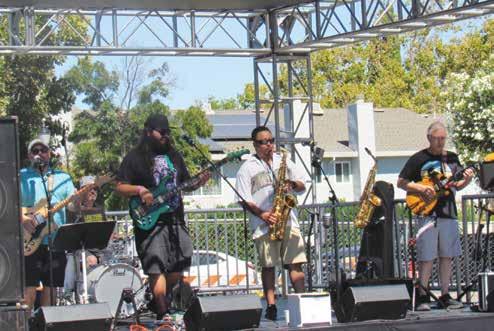


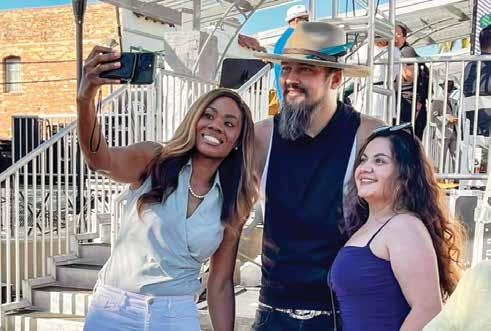
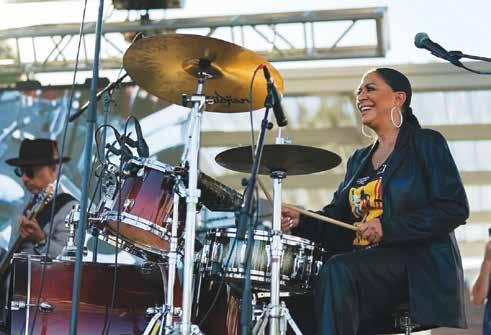
9 Community News, Youth Voice www.richmondpulse.org Fall 2023
EDUARDO TORRES
FunkyTim & the Merlots, a California band that features members of the 209 All-Stars, performed at the Pittsburg Seafood and Music Festival.
EDUARDO TORRES
The Pittsburg Seafood and Music Festival returned for the first time since 2019 after taking the last three years off because of the pandemic.
EDUARDO TORRES
Percussionist Pete Escovedo, also known as "Pops," was among the musical headliners at the festival.
MARCOS LOPEZ
Legendary drummer Sheila E., the daughter of Pete Escovedo, also performed at the Pittsburg Seafood and Music Festival.
MARCOS LOPEZ
Mayor Shanelle Scales-Preston take a selfie with country music artsist Clayton Q and council member Angelica Lopez.

10 Community News, Youth Voice www.richmondpulse.org Fall 2023
El Sobrante Stroll Fills San Pablo Dam Road With Festivities
BY DENIS PEREZ-BRAVO
Thousands of East Bay residents walked San Pablo Dam Road between El Portal Drive and Appian Way during El Sobrante Stroll on Sept. 17.
It was the 28th annual occurrence of the event that bills itself as “The Best Dam Road Block Party in the East Bay.” More than 100 vendors along the corridor showcased their services, attractions, products and information from 11 a.m. to 4 p.m.
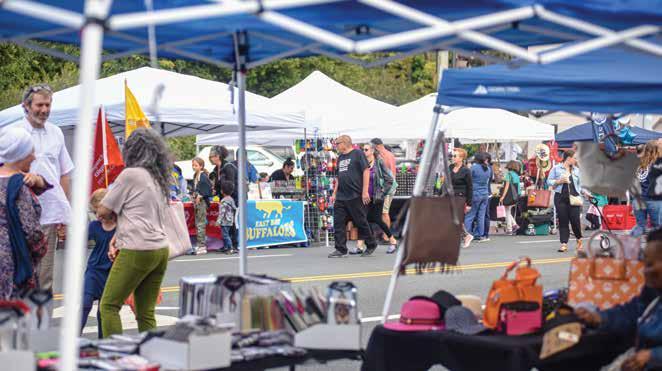
"I am here to give publicity to my business," said Raquel Argueta, owner of Anahi Handmade Jewelry.
She had never participated as a vendor in any event but said the stroll is a community event for which she felt comfortable taking this step as a business owner.
"And I feel confident," Argueta said with a smile on her face and her handmade earrings dangling off her ears.
All week she worked hard to create handmade jewelry. Those new creations in addition to her inventory already created decorated the table at her booth during the stroll.
El Sobrante Chamber of Commerce, the organizing party, advertised there could be up to 200 vendors.
The event began with a parade filled with marching bands like that of Richmond High School and a caravan of horses.
Attendees then filled the street to shop from local businesses and watch the different music shows scattered around the event.
John Jay, 58, and his family shopped for hats at one of the vendors. He goofed around as he grabbed and put on a Disney's “Frozen” hat. His family laughed along with him.
"I am enjoying the diversity," Jay said.
This was his first time attending the El Sobrante Stroll, but he is no stranger to such events as he has attended the Solano Stroll many times.
He appreciated that El Sobrante Stroll had a car show and showcased different communities.
Salma Muzaffa, a henna artist from El Sobrante, was happy to be part of bringing unique experiences to participants. "This year, I saw that there were a lot of people getting henna for the first time," Muzaffa said.
Being able to give that experience to people, especially people she sees around town when she is just "out and about'' doing errands, is the reason she continues to participate in the stroll.
Outside of The Pedaler bike shop, people stopped
their walks to watch a BMX show hosted by TGC Action Sports. The hosts pumped up the crowd during the final trick of the performance asking them to chant "backflip." Soon, the cyclists pedaled at full speed and after leaving the ramp, flipped backwards with their bikes as the crowd cheered.
Close by, in the parking lot of the closed PJ's Restaurant & Cocktail, dozens of classic cars were being admired. Different models and years were on display. Car owners sat and talked around their cars as patrons walked by or took pictures with the cars.
El Sobrante Chamber of Commerce is also hosting the Stroll's Photo Contest, open to anyone who attended the event and took a photograph. To enter, send the photos and contact information to 2023stroll.photo.contest@ gmail.com. The winner will receive cash or a gift card. All entries become the property of the chamber, which did not specify when the contest ends. •
San Pablo City Council Hears Housing Plans
BY MITZI PÉREZ-CARO
S an Pablo city staff presented its environmental impact report on the housing element of the city’s general plan, and San Pablo Economic Development Corporation presented its homeownership program to the City Council on Sept 5.
A draft of the city’s environmental impact report on the housing element was first presented to the City Council on Aug. 18, 2022. It was amended before being presented to the state, as all cities are required to do. A city’s general plan is its blueprint for future developments. The housing element is the long-range plan to expand housing and affordability. The environmental impact report analyzes potential consequences of the housing plan, ways to reduce or avoid them and alternatives.
“We need to be mindful to dream of ideas to better our city,” said Mayor Abel Pineda. “We want to ensure that we have the best possible situation.”
On Sept. 18, the second draft will be resubmitted to the California Department of Housing and Community Development for review. If all goes according to plan, on Dec. 19, the city planning commission will hear the new report for review and there will be another City Council hearing Jan. 8, 2024.
City staff missed the deadline to submit the housing and community development portion. According to city staff, almost all Bay Area communities missed the Sept. 30, 2022, deadline. Reportedly, only one or two Bay Area communities met it.
The hope for city staff is that the second draft of the environmental impact report will be compliant and certifiable.
In addition to the impact report focusing on housing, the council reviewed the annual services and updates from the city’s economic development corporation. One of the topics of discussion for the EDC was its homeownership program.
The goal of the homeownership program is to educate first-time home buyers in a series of 12 webinars and put them in connection with professionals.
Council member Arturo Cruz asked if the EDC was working in partnership with Lao Family Community Development, which also provides housing services
in San Pablo. EDC’s Leslie Choi said they are working together and that the program is offered in 20 or more different languages.
There were 137 inquiries in the last cycle.
Council member Elizabeth Pabon-Alvarado asked what the planning and outreach looked like, saying, “I feel like understanding these programs are a little bit difficult because of our demographics.” To which Choi responded that engagement is the goal of the program.
Participants are able to receive a San Pablo Loan Assistance for Sustainable Housing, shared appreciation loan, a Workforce Initiative Subsidy for Homeownership grant or both. The SPLASH loan is up to 20% of the home value for a 30-year term with 3% per year simple interest. The WISH grant will match up to $29,000 with a 4:1 match and 100% forgiven for 5 years.
Out of the 137 inquiries, two families received the SPLASH loan and three families received the WISH grant. The process took 18 and 20 months, respectively.
“SPLASH and WISH are now at a different place from the last presentation, investment in education needed to be made,” said Pineda. “There were lessons learned. The housing crisis continues to impact what you all can do.”
“We will continue to work with companion programs,” said Choi. “From workshops, we will present and evolve.” •
11 Community News, Youth Voice www.richmondpulse.org Fall 2023
DENIS PEREZ-BRAVO
San Pablo Dam Road was closed to traffic for a few hours Sept. 17 for El Sobrante Stroll, which featured more than 100 vendors, classic cars, a BMX bike show and a parade with marching bands and horses.
RICHMOND PULSE Your Ad Can Be Here! Contact us at info@richmondpulse.org
Being Mixed Gives Me an Open Mind and Empathy
BY NATASHA KAYE
Editor’s note: In this series, we tell the stories of mixedrace youth in the Bay Area. They share with us how they navigate other people’s preconceived notions and how growing up with more than one race and culture has shaped them and their worldview. At a time when people seem increasingly hateful and divided, they are living proof of love bringing people together.
All ethnically ambiguous people have heard the words, “What are you?” throughout our lives. For some, this phrase may evoke feelings of frustration and irritation, for others, it’s so common we’ve learned to laugh at it.
But for every time someone points that question in our direction, we have to figure out the best way to explain “what,” or rather, “who” we are.
My go to response is simple. I say, “I’m Peruvian and white.” I think it’s straightforward and if people are still left with questions, they can ask, but I don’t usually feel the need to explain myself any further.
Typically my response is met with something along the lines of, “I knew you weren’t fully white” or “I thought you were Asian!” Normally, these comments don’t bother me — I can’t blame people for being curious. But sometimes someone will say it with just the right inflection, with just the right amount of dismissal, that makes my existence feel as though it isn’t enough.
Being mixed-race, there were often moments I was told I wasn’t “Latina enough” or “white enough” to do x, y, z. Sometimes, these were jokes from friends or family, but sometimes they weren’t.
To some, my American last name and white father were enough to make them feel as though my claim to Latina status was unwarranted. To others, my brown eyes and tan skin were enough to pin me as the token person of color.

Either way, half of my identity was used to paint a complete picture of myself so it would fit neatly in their worldview. And either way, they were wrong.
Being mixed-race is exactly that — we are mixed. We are all the beautiful and all the ugly parts of our cultures, families and experiences, and that mixture is what makes us… us.
Because I’ve grown up immersed in two entirely different cultures, I’ve always been eager to engage and experience customs different than mine. I’ve felt the pain of having one or both of my cultures ridiculed, so I’ve tried to move through my life with an open mind. I’ve
County Highlights
Anti-Human Trafficking Efforts
BY SAMANTHA KENNEDY
The Contra Costa Board of Supervisors on Sept. 12. received a report on the county’s efforts against human trafficking, including resources offered to victims.

“The network that’s been built is so important in working with our community partners,” Vice Chair Federal Glover said. “We’ve come a long way. When you look out and see what’s taking place, we still have a long way to go.”
The presentation coincided with a press release by the

grown up appreciating different traditions and embracing standards that others may feel are wrong because they aren’t theirs. It’s forced me to keep an open mind and consider how culture shapes us, especially when others may try to dismiss aspects they don’t understand.
I truly believe my mixed heritage has allowed me to develop such a passion for journalism, for seeing the other side and trying to understand instead of judge. Especially at a time like now, when cancel culture is rife and discourse is limited, I find it easier to withhold judgment because I’ve most likely heard my own loved ones say something we now consider problematic.
When I hear my Latino uncles say derogatory statements about the LGBTQ+ community, I don’t attack them; I ask them why they feel that way, and without fail, their answers come back to a deeply rooted sense of machismo — something that as much as I despise, I know is embedded in our culture. I don’t think it’s my job to change them, but I do think it’s my job as a journalist and a loved one to understand and empathize, even when I wholeheartedly disagree.
When I hear my conservative, white family complain about immigrants “taking over,” I know attacking them and labeling them as racists will do nothing to help. Trust me, I’ve had my fair share of moments holding back screams and tears feeling as if my own family doesn’t even want my mom here, and honestly, maybe they don’t, but for every racist thought they’ve had or microaggression they’ve muttered, being mixed has forced me to try and empathize. In talking to them on
Contra Costa District Attorney’s Office announcing the arrest of a Diablo Valley College instructor and track coach who is accused of nine felonies, including human trafficking.
Services funded by Contra Costa’s Employment and Health Services Department for anti-human trafficking efforts totaled nearly $1.5 million in the 2022-23 fiscal year. Services include both prevention and intervention, such as community education and direct support for victims, that are facilitated through several county and community organizations.
“There are tools at the local, state, and national level to help curb human trafficking and connect victims to trauma-informed services,” Contra Costa District Attorney Diana Becton said in the press release. “For example, our office has a local human trafficking hotline, we have community-based service partners like Community Violence Solutions, and there’s a national toll-free helpline that’s available 24/7.” That helpline can be reached by dialing 211.
Supervisor Diane Burgis said she appreciates current anti-human trafficking efforts by the county and community organizations that focus on the victims, but also said that holding all perpetrators, especially ones that exert the most power and have the most money, accountable is something she wants the public to know is a priority.
Melody Saint-Saens, division manager for the Contra
their anti-immigrant views, it’s clear it all comes down to fear. Fear of change, because as white people in America they’ve always had it pretty good, and seeing different colors switching things up and threatening their status is scary to them. As a mixed-race person from the Bay, obviously that idea feels ridiculous, but for white people in rural America, I can see how that can be scary.
To some, my stance on this may feel wrong. You may believe it’s my job to educate and reject problematic notions wherever possible. But I disagree. I cannot put that burden on myself all the time so instead, I chose to listen and learn. It’s OK — we can agree to disagree. I think we need more of that in this world. After all, I think agreeing to disagree is how my two families have stayed relatively civil throughout the years.
So to all my mixed-race people out there, I get it. Balancing two or more cultures at once is always a challenge, but it’s a beautiful one and one we must remind ourselves to be grateful for.
This resource is supported in whole or in part by funding provided by the State of California, administered by the California State Library in partnership with the California Department of Social Services and the California Commission on Asian and Pacific Islander American Affairs as part of the Stop the Hate program. To report a hate incident or hate crime and get support, go to https://www. cavshate.org/.•
Costa Alliance to End Abuse, said that targeting perpetrators in addition to helping victims is a priority for the county.
The county conducted inspections at 18 massage establishments that were suspected of human trafficking for either labor or sexual trafficking. In San Ramon, those inspections resulted in one permanent closure, one sold business and two current investigations. From these illegal establishments, eight human trafficking victims were offered services.
Supervisor John Gioia previously called for further investigation into unpermitted spas after two people died of Legionnaires’ disease at an unpermitted spa.
In some cases, according to Saint-Saens, human trafficking victims are often forced to help commit crimes like human trafficking.
“There’s not just one solution that fits every situation,” Saint-Saens said. To navigate these complex situations, Saint-Saens said developing community partnerships and involving survivors is an important tool to better serve the community.
One solution California lawmakers have come up with to both protect survivors who may have been forced to help traffickers from prosecution and hold actual perpetrators accountable is Senate Bill 14. The bill, which passed 79-0 on Sept. 12, would make child sex trafficking a serious felony and require longer sentences for offenders who have committed certain crimes. •
12 Community News, Youth Voices www.richmondpulse.org Fall 2023
“For every racist thought they’ve had or microaggression they’ve muttered, being mixed has forced me to try and empathize,” the author writes. (Photo courtesy of Natasha Kaye)

























 BY EDUARDO TORRES
BY EDUARDO TORRES








